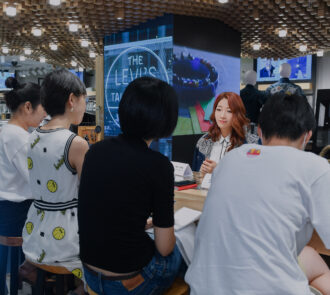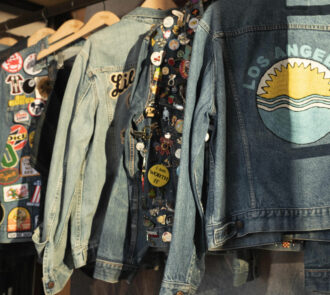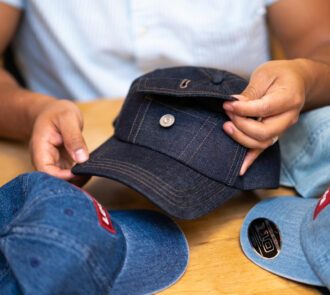
About Our Sustainability Reporting
An honest review of our performance
Report Scope and Content
Except where noted, this report covers performance during our fiscal year 2021 (November 30, 2020 through November 28, 2021). Where we believe it is meaningful to readers, and as noted in the report, we have provided more current information. Similarly, where fluctuations naturally occur throughout the year, as with the number of factories participating in certain programs, we have reported as of specified dates. Unless indicated otherwise, metrics include consolidated data from the company and its subsidiaries. In September 2021, we acquired Beyond Yoga®, and its sustainability data has not been included unless indicated otherwise.
Our reporting is based on the underlying disclosure context. When appropriate, certain sections of this report focus on our company-operated corporate offices, distribution centers, factories and retail stores across all our geographic regions. At other times, we include information related to third parties that manufacture, distribute or sell our products, including suppliers, vendors, contractors, licensees and other partners. Data inclusions and exclusions are clearly noted.
Report content was informed by an update to our sustainability issue prioritization assessment completed in early 2022. This assessment — which built on our comprehensive 2021 sustainability issue prioritization assessment — confirmed our priority topics based on their impacts to society and the environment, as well as to our business. Our sustainability issues matrix shows how the issues have been prioritized.
Forward-Looking Statements
This Sustainability Report Summary and related website contain forward-looking statements, including statements related to our sustainability strategies, initiatives and targets. We based these forward-looking statements on our current assumptions, expectations and projections. These forward-looking statements are estimates and involve a number of risks and uncertainties that could cause actual results to differ materially. These risks and uncertainties are detailed in our filings with the U.S. Securities and Exchange Commission, including our Forms 10-K and 10-Q. Other unknown or unpredictable factors also could have material effects on our future results, performance or achievements. All information in this Sustainability Report and related website was current only as of the date originally presented and we disclaim any obligation to update this information.
What We Mean When We Say
Levi Strauss & Co., LS&Co., the company, us, we or our: Unless specified otherwise, these terms refer to our global operations, encompassing all of our company-operated physical locations, including retail stores, distribution centers, manufacturing facilities and administrative offices. Our company-operated retail locations include leased locations as they are operated by us in accordance with LS&Co. standards. These terms are used for convenience only and are not intended to identify one particular entity, location or brand.
Levi Strauss Foundation: The Levi Strauss Foundation, an independent legal entity, advances the human rights and well-being of underserved people in places where LS&Co. has a business presence.
Red Tab Foundation: The Red Tab Foundation is a public, nonprofit foundation funded by employees, shareholders and retirees that assists LS&Co. employees, retirees and their families when they face unexpected financial hardship.
Suppliers or vendors: These are independent third parties with which we have a direct contractual relationship to produce our apparel and accessories. They make up our Tier 1 supply base and include both “cut and sew” suppliers and laundries, more broadly referred to as factories. All of our suppliers operate their own businesses and manage their own facilities. They are expected to operate in compliance with our Supplier Sustainability Guidebook, Product Safety by Design Framework for Restricted Substances List (RSL) and Supplier Code of Conduct. Tier 2 includes those facilities where our Tier 1 suppliers get their fabric, threads, buttons and other materials, commonly referred to as “fabric mills” or simply “mills.”
Company-operated factories: These include LS&Co.’s two factories in Plock, Poland, and Cape Town (Epping), South Africa.
Reporting Frameworks
This sustainability report was informed by the Global Reporting Initiative (GRI) Standards (2021), the Task Force on Climate-related Financial Disclosures (TCFD), as well as the Sustainability Accounting Standards Board (SASB) Standard (2022) for the Apparel, Accessories & Footwear industry. Progress on relevant metrics from the SASB Multiline and Specialty Retailers Distributors Standard and the SASB E-Commerce Standard is also included.
This report reflects our commitment to the 10 principles of the United Nations Global Compact (UNGC), which addresses human rights, labor, environment and anti-corruption for business. Likewise, we are a signatory to the UNGC CEO Water Mandate. This report serves as our 2022 Communication on Progress (COP) for both the UNGC and the CEO Water Mandate.
LS&Co. supports the UN Sustainable Development Goals (SDGs), which provide a global framework for advancing sustainability. Throughout this report, we have included relevant SDG icons to indicate the places where our work aligns with specific SDGs.
We stay current on the latest reporting frameworks and support efforts toward reporting convergence designed to make it easier for stakeholders to find and compare sustainability information across organizations. For instance, we are engaged and monitoring standards setting activities, including but not limited to, the IFRS Foundation and GRI coordination, the U.S. Securities and Exchange Commission’s proposal for climate-related disclosure rules and the World Economic Forum’s intention to set disclosures for non-financial reporting.
View our reporting frameworks on the ESG indices page or in the Resources section of this page.
Data Verification
We are committed to data accuracy, comparability and consistency that enables year-over-year assessments of our sustainability progress. We applied our internally developed substantiation process to the information and disclosures provided in this report. This included review of report content to reliable external and internal evidence, including system-generated reports, external assurance reports, confirmations of partnerships with third parties, certifications received, involvement in campaigns, accreditations or awards received. Differences from industry standards, assumptions, estimates or models used in the information are clearly referenced and explained. Additionally, the report is reviewed by an internal cross-functional team to ensure our disclosures are presented clearly and consistently. While this process gives us confidence in the integrity and accuracy of our data and disclosures, it is not a substitute for third-party assurance.
In 2021, we continued evolving our approach to sustainability data verification and management of sustainability claims as part of our commitment to continued improvement and in preparation for mandatory disclosure regulations in the U.S., Europe and other regions. Going forward, our Legal, Finance and Sustainability teams will continue collaborating to review sustainability performance data and claims to meet our own — and our stakeholders’ — high expectations for accuracy.
We also sought and received external assurance from a third party with respect to certain emissions, energy and philanthropic information in our report. Where applicable, we have noted this in the report.
Transparency Beyond Reporting
Annual sustainability reporting is not the only way we share our sustainability journey. We maintain a suite of sustainability policies, resources and commitments. We are aligned with the Transparency Pledge as part of our commitment to meaningful corporate accountability. We publish the list of our manufacturing suppliers which represent 100% of our Tier 1 suppliers, as well as the majority of our fabric mills — our Tier 2 suppliers. LS&Co. suppliers can be viewed through the Open Apparel Registry.
We report to CDP, where we share our climate action approach and progress. We scored an A- on our 2021 CDP climate disclosure for transparency and actions to combat climate change during FY20.
In 2021, we were the top-rated company in the Green Supply Chain CITI Evaluation, managed by the Institute of Public and Environmental Affairs, a leading environmental NGO in China. The CITI evaluation ranks brands’ management of the environmental impact of their supply chains in China. We were also the top-rated pure apparel brand (and #5 across all sectors) in IPE’s new Corporate Climate Action Transparency Index (CATI), developed in 2021. The CATI evaluation assesses performance on corporate and value chain-level climate action performance, awarding points for actions related to greenhouse gases (GHGs) in proportion to a company’s GHG emissions.
We continue to lead positive change in our industry by sharing many of our sustainability learnings. For instance, we have made our Supplier Sustainability Guidebook publicly available, disclosed our Water<Less® techniques and shared the Screened Chemistry approach we developed. By open-sourcing our learnings, we welcome others to join us in moving the industry forward.











